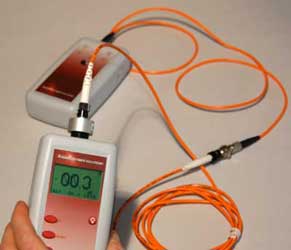Checking Out the Advantages of Optical Fiber Testing for Improved Interaction Systems
The significance of optical fiber testing in contemporary interaction systems can not be overstated, as it serves as a foundation for ensuring network integrity and performance. This aggressive testing technique has profound ramifications for signal quality and operational efficiency, increasing the question of how these techniques contribute to lasting sustainability in an ever-evolving technological landscape.
Significance of Optical Fibre Testing
The significance of optical fiber screening can not be overstated in today's data-driven setting. As organizations progressively rely on high-speed information transmission for everyday procedures, the stability and performance of optical fibre networks are vital. Evaluating guarantees that these networks can support the huge amounts of information generated and sent seamlessly, fostering effective communication and connection.
Optical fiber testing offers numerous vital functions, consisting of confirming installation quality, determining potential faults, and identifying general system performance. Normal screening can protect against expensive downtimes and solution interruptions, permitting organizations to preserve operational connection. It helps in conformity with sector standards and policies, making sure that fibre optic installments fulfill called for specs for security and dependability.
Furthermore, testing can enhance the long life of fiber optic systems. By proactively identifying issues such as signal loss, depletion, or port failings, companies can attend to issues before they escalate, hence expanding the life of their framework. In summary, optical fiber screening is not just a technical requirement yet a calculated investment that boosts network dependability, enhances performance, and eventually sustains the development and performance of contemporary interaction systems.
Trick Evaluating Techniques

OTDR is a vital method made use of to identify mistakes, action splice losses, and examine the overall honesty of a fiber optic web link. By sending out a pulse of light down the fibre and evaluating the shown light, service technicians can identify locations of mistakes and examine the network's performance over cross countries.
Insertion loss screening measures the quantity of signal loss that occurs when light go through a link or splice. This method is crucial for verifying that links satisfy specified loss limits, which is vital for maintaining ideal efficiency in communication systems.
Optical return loss testing measures the quantity of light showed back in the direction of the resource as a result of blemishes in the fibre or connections. High return loss values indicate better efficiency and minimized signal degradation.
Together, these screening click here to read approaches provide an extensive evaluation of fiber optic networks, guaranteeing their dependability and performance in varied communication applications.
Influence On System Performance
Efficient optical fiber screening directly influences the overall performance of interaction systems. By ensuring the integrity of fiber optic wires, screening determines prospective faults such as attenuation, splice loss, and adapter imbalance. These concerns can dramatically weaken signal top quality, causing disruptions and decreased data transmission rates.

Furthermore, regular optical fiber screening contributes to long-term system sustainability. It makes it possible for early discovery of wear and tear, permitting for timely upkeep and upgrades before major failings occur. This not just prolongs the life expectancy of the infrastructure however additionally ensures that interaction systems remain competitive in regards to performance.
Cost-Effectiveness and Effectiveness
Cost-effectiveness is an important factor to consider in the deployment and maintenance of optical fiber networks. Implementing robust optical fiber screening procedures can substantially reduce operational prices by identifying problems prior to they rise into major issues. optical fibre testing equipment. By spotting faults, depletion, and various other efficiency hindrances early, organizations can prevent expensive repair work and downtime, which can disrupt services and result in revenue loss
Moreover, reliable screening methods improve the installation procedure, enabling service technicians to work a lot more successfully. This equates to lower work expenses and faster project conclusion times. Advanced testing equipment, such as Optical Time Domain Name Reflectometers (OTDRs), allows a precise analysis of fibre high quality, guaranteeing that just ideal products are used, therefore lessening waste.
Regular screening also adds to much better source allowance. By understanding the network's efficiency, organizations can make educated decisions regarding upgrades and expansions, making sure that article investments are made where they are most needed. In recap, optical fiber testing boosts cost-effectiveness and effectiveness, sustaining the long-term sustainability and competition of interaction systems in a progressively requiring market.
Guaranteeing Long-Term Integrity
Implementing extensive optical fiber testing not just boosts expense financial savings and operational effectiveness yet also plays an essential duty in guaranteeing the long-lasting reliability of communication networks. Constant screening practices, including attenuation and transmission capacity assessments, help determine potential deterioration in fiber efficiency before it results in solution disturbances.
By using advanced testing methods, network drivers can determine mistakes or weak points in the fibre infrastructure, enabling for timely removal. This positive method lessens downtime, guaranteeing that communication systems remain practical and reliable. Furthermore, regular testing contributes to the advancement of a much more durable network, as operators can adapt and maximize their infrastructure based on real-time data understandings. ofda.
In addition, making certain conformity with market requirements through optical fibre screening enhances the high quality and stability of the entire communication system. This adherence not just boosts self-confidence among stakeholders but additionally lines up with regulative requirements, which are significantly rigorous.
Final Thought
In final thought, optical fibre screening offers as a fundamental component in boosting communication systems. By employing numerous testing methods, such as OTDR and insertion loss analyses, networks can accomplish optimal efficiency and dependability. The proactive recognition of faults not just enhances signal quality yet likewise reduces downtime, inevitably adding to cost-effectiveness and functional effectiveness. Furthermore, adherence to sector standards cultivates stakeholder confidence, ensuring the long-lasting sustainability of communication facilities in an increasingly data-driven landscape.